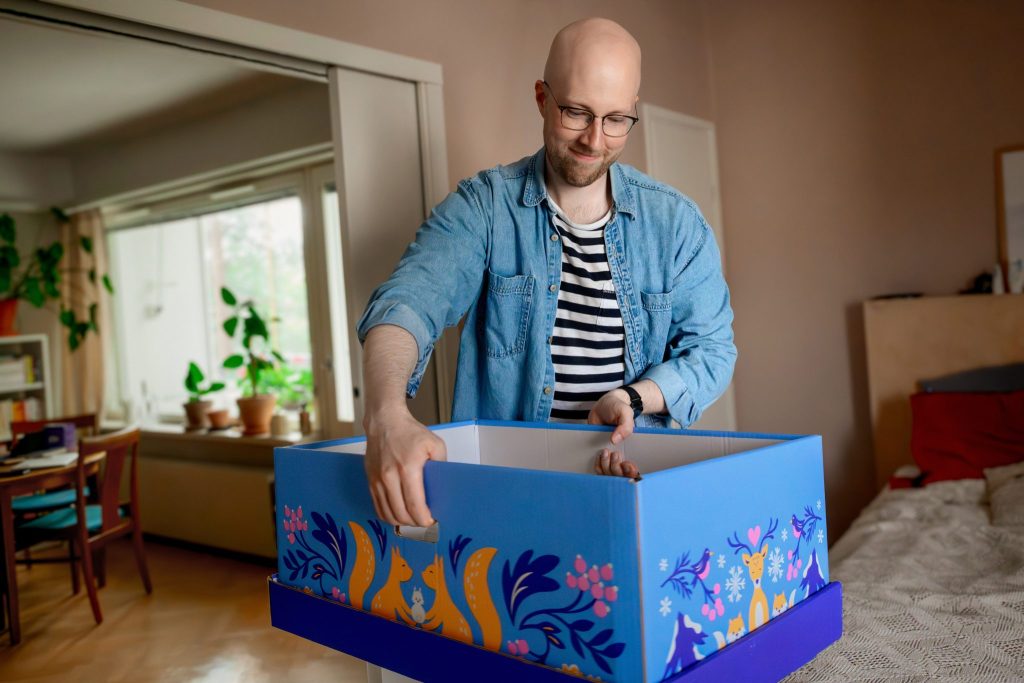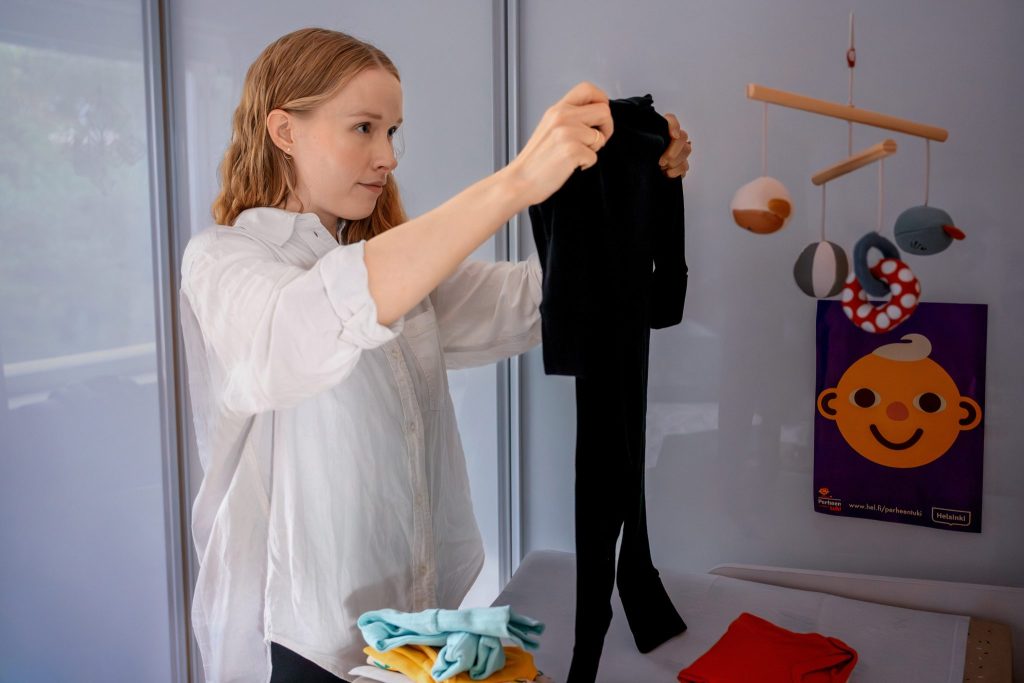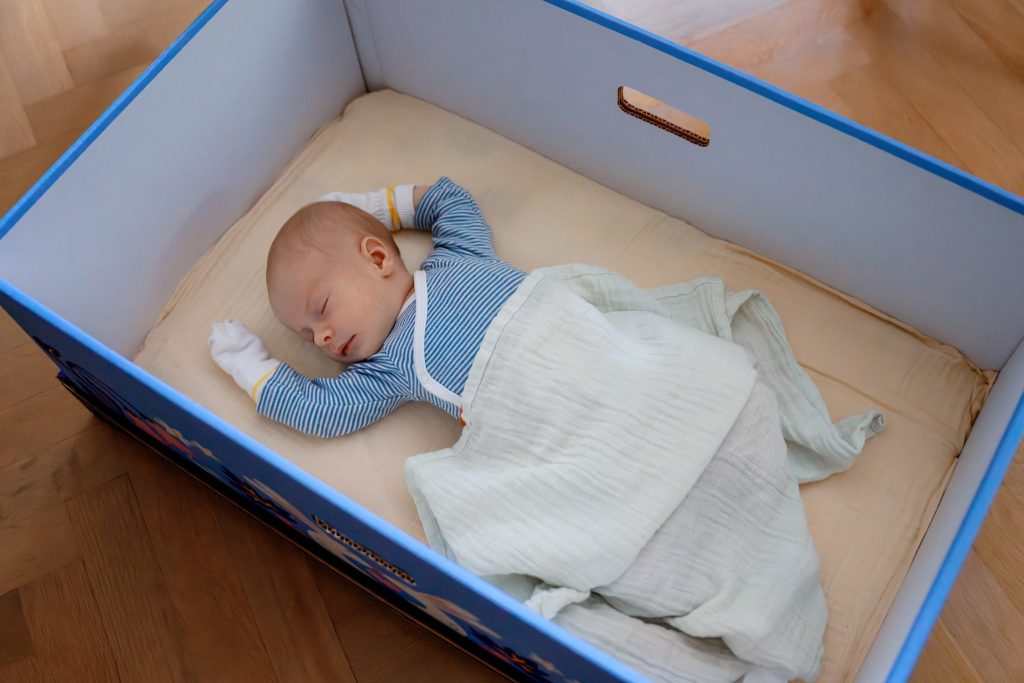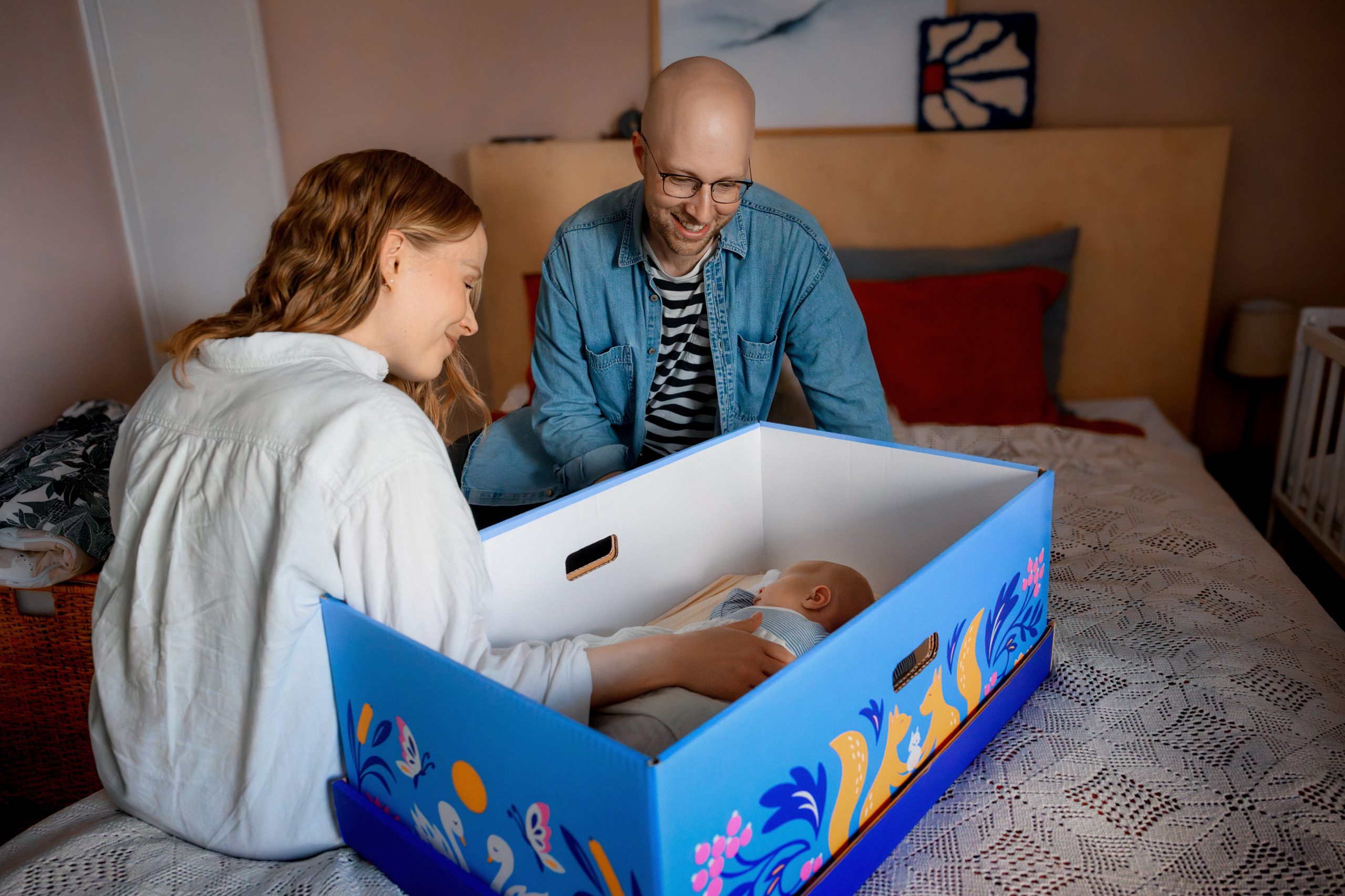Anna and Daniel Nord, 32 and 31, proudly show their newborn son. He represents a major change in their lives. They have been living in Helsinki for a few years, he is a journalist and she is a language specialist.
A luxurious box
Daniel and Anna are very happy with their baby box. Parents are given a box after visiting the child health clinic a few months before the birth of their baby.
“It feels a bit more real when you see the little clothes… and you start to dream a little,” says Daniel. To them, it felt like a milestone and quite a luxury, a kind of caring gesture from society.
Read this article in Norwegian on Arbeidsliv i Norden
The baby box
The products are selected through public procurement, with a focus on price, quality, environmental sustainability, and working conditions – including a ban on child labour and support for trade union rights.
Around 45,000 children are born in Finland each year — a figure that is declining, as it is in the rest of the Nordic region.
Since 1949, all newborns have received a maternity package: either a box or €170 in cash. Two-thirds choose the box.
The purpose is to promote the health and wellbeing of both the expectant parent and the child. The name has not been modernised, despite criticism.
The benefit is a tax-free social allowance, similar to child benefit.
The box weighs 8 kg and contains 38 items (as of 2025): baby clothes, hygiene products, and more. The contents are gender-neutral and updated annually.
They describe the baby box as a concrete and thoughtful start to parenthood. It is about creating a sense of safety in a confusing time; the first two months of the child’s life are secure.
The box and everything in it gave them a feeling of being on top of things, explain Daniel and Anna. But it also gave them an idea about how much a child needs, beyond just clothes.
Anna felt it was nice not to have to get hold of everything herself, that there was something to start off with.
A proud Finnish tradition
Many Finns have spent their first months sleeping in the baby box, which also contains a small mattress. Many later turn the box into a storage space for memories from that first period in the baby’s life.
“As a Swede, I feel this is a great Finnish tradition. I have told family and friends back in Sweden what a brilliant idea it is,” says Daniel Nord.

When his wife Anna was born, her parents were given the same type of box. She does not know whether she ever slept in hers, but in old family photos, she recognises some items of clothing from the box.
A tradition from a poorer Finland
In the late 1930s, after the civil war, infant mortality was high in a Finland that was much poorer than today. The “maternity grant” was introduced in 1938. Mothers should be encouraged to visit health clinics.
The box was filled with useful products, clothes, fabrics and soaps – initially intended only for families with limited means.
Ten years later, after two more wars, this social service was extended. The maternity grant was given to everyone, regardless of income and wealth. In cramped Finland, it felt important to give the child a calm space, so the box also became a calm and clean place to sleep.
The box evolves with time and provides guidance to parents
In the 1960s, a small sleeping bag was added. The idea was to encourage families to allow their children to sleep outside, for health reasons.
When baby bottles were removed from the contents of the box, the hope was that this would increase interest in breastfeeding.
In the 1970s, condoms and lubricants were also included. This sparked debate but was justified as concern for the women’s well-being. The removal of condoms has been blamed on procurement issues, but it also aligns with the desire to encourage more children in Finland.
Unique to Finland for a reason
Finland is the only Nordic country that has a baby box, but the solution has been introduced in various forms in other countries around the world. Assistance for newborns comes in different forms, and even a universal child benefit is far from a given outside the Nordic countries.
Daniel and Anna have not made it a priority to compare family benefits. Their move to Finland was not determined by the baby box.
“In Sweden, we don’t have a baby box, but instead you get more days off as parental leave. You can save your days for longer, and there are other aspects as well,” Daniel points out.
Indeed, Sweden’s 18-month parental leave is the longest in the Nordics. Finland comes second with 13 months, while the other Nordic countries have slightly shorter periods of leave.
Norway, where living costs are also high, has the highest income-based maximum allowance. In both Sweden and Finland, the maximum allowance is around €2,200 per month.
Shared parental leave – obviously
Iceland is the most gender neutral, where parents share parental leave equally between them. It cannot be transferred from one to the other.
In Sweden, both mothers and fathers are entitled to 13 weeks of earmarked parental leave. In Finland, parents get 16 weeks each; the rest is time they can share.
Anna took pregnancy leave before giving birth, and now her parental leave has started. Daniel and Anna plan to share the parental leave equally.
“It feels right. Neither of us is thinking of giving up any days to the other right now, that is obvious. I very much want to have time with our boy later, to take daddy leave and spend time with him. It feels exciting to do that,” says Daniel, who reckons this will happen towards the end of their son’s first year.
Political ambitions
The Finnish baby box gets international attention but is also being debated at home – not only among parents but on a political level too.
The Finnish government includes two former top athletes with Olympic success. During the latest parliamentary elections, parties started talking about the importance of exercise and the need to include a ball in the baby box.
During the 2023 government negotiations, it was decided that a ball will be included from next year, and family exercise advice will be introduced at maternity and child health clinics.
“It feels like there has been talk about this ball for several years now. They have got plenty of talking points out of that ball,” say Daniel and Anna, who have not had time to miss the ball during the first couple of weeks.
Given a choice
It has always been possible to choose a sum of money instead of the baby box. Right now, it is €170. Two-thirds of parents still choose the box which contains around thirty items of clothing and care products, even though not everything feels equally useful, and the sizes do not suit everyone.

“With our first child, choosing the baby box felt like the obvious thing to do. It might be different later if we have more children. We might reconsider whether we need another box,” say Anna and Daniel.
Anna points out that the clothes are of a high quality and can be used by several children, which is especially useful since babies soon grow out of their clothes.
People’s capitalism from the cradle
During the 2023 government negotiations, it was also decided to explore the possibility of a share investment account for newborns. The state would donate the first investment to each newborn Finnish child as part of the maternity package.
The idea was to help Finns achieve “world-beating economic literacy” and improve all citizens’ chances to achieve prosperity.
How this will be organised remains to be decided.
Child support for all?
Parallel with talk of share investment accounts for newborns, there is a debate about whether child support should be given to all families, regardless of their financial situation, while the state is forced to make cuts across all areas.
Daniel thinks it is good that the benefit is not means tested. But he understands that it also may grate and feel unfair that those who are very well off also receive child benefits, which they do not really need.
There are no concrete proposals for a change to this in Finland, but cost-cutting proposals are coming thick and fast.
The Finnish child benefit for a firstborn is €94.88 per month, with an added €26 per month during the child’s first three years.
The benefit increases for each consequent child – for child number five, it will be €192.69 a month. In Åland, the child benefit is slightly higher, by a few tens of euros.
Running out of time to have children
For Daniel and Anna, having a child felt like a natural step. But that is no longer the case for everyone.
It is hard to say why fewer children are being born. Perhaps because people wait a long time before trying to have children, and then realise it is not that easy, wonder Daniel and Anna.
An insecure labour market could also play a part, as people feel less economically safe. Many want a steady job rather than short-term contracts before committing to having children. Others live far away from their support networks.

Anna comes from northern Finland, where most of her friends had at least one child by the time they were between 25 and 30. But her friends in Helsinki, who are between 30 and 35, either have no children or have just had their first.
Daniel has seen the same pattern in Sweden. In bigger cities, it is common to wait much longer before having children. But in places where people settle down earlier with a job and a house, they also tend to start families sooner.
So it is a question of lifestyle and security. Across the Nordic countries, there is growing concern over falling birth rates. But is it actually possible to tempt people with generous maternity packages or slightly higher child benefits?
“No, I don’t really think so. Of course, a sense of security matters. There is support through the health services, you get some baby things and the child benefit. This gives you a kind of reassurance. But that’s not what makes you decide to have a child,” says Daniel.






